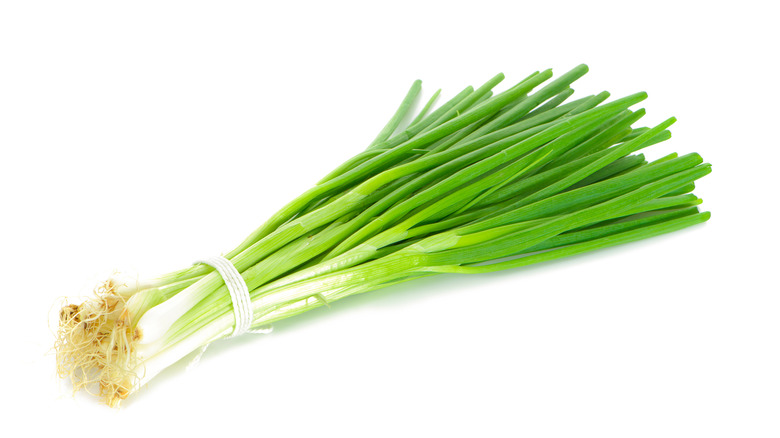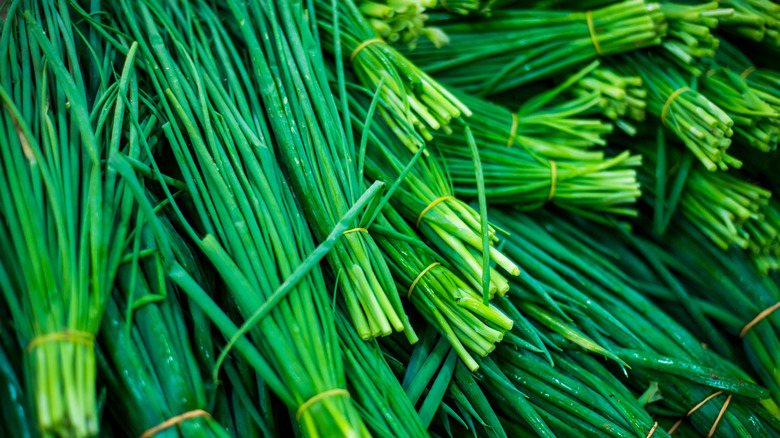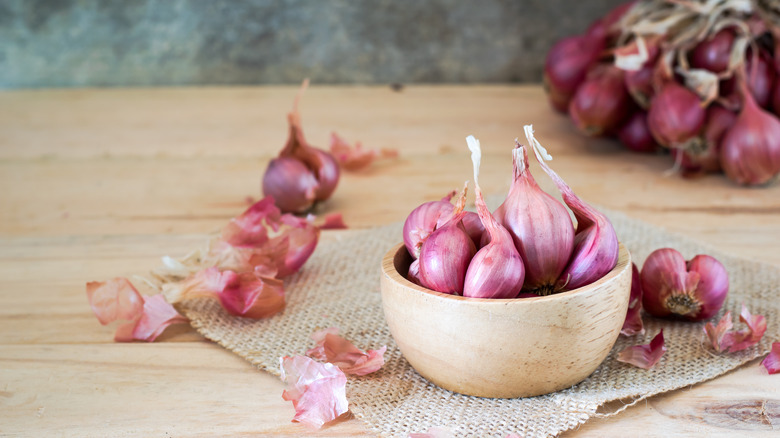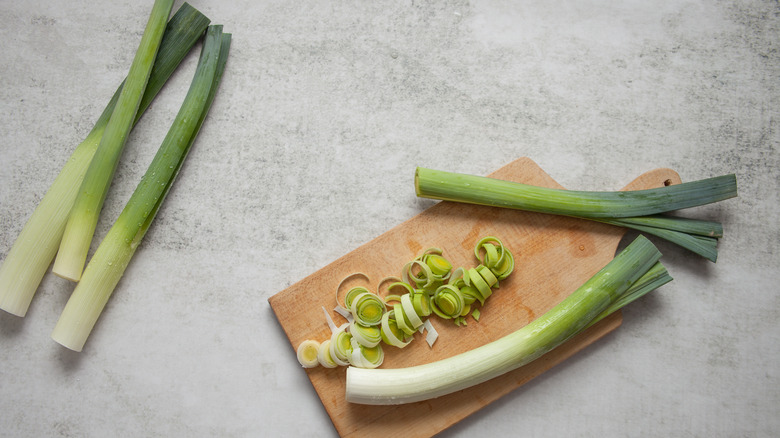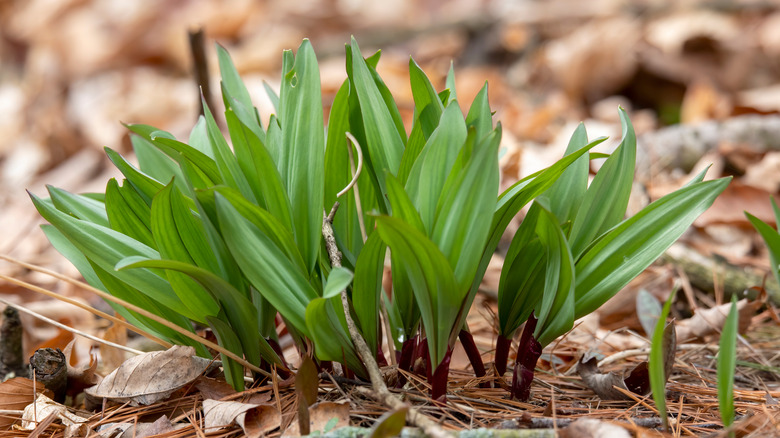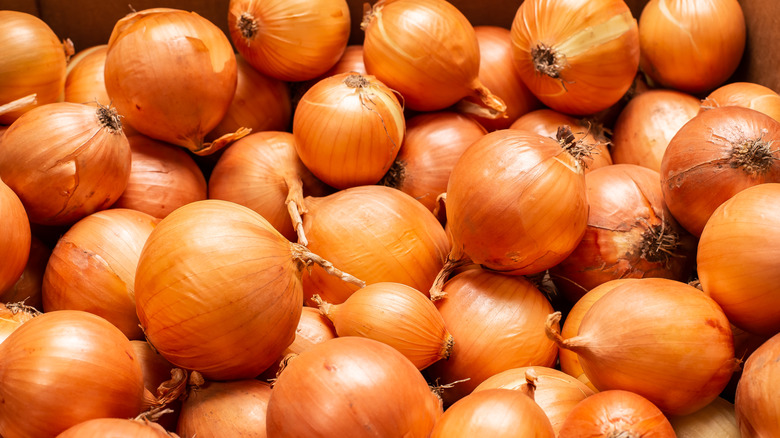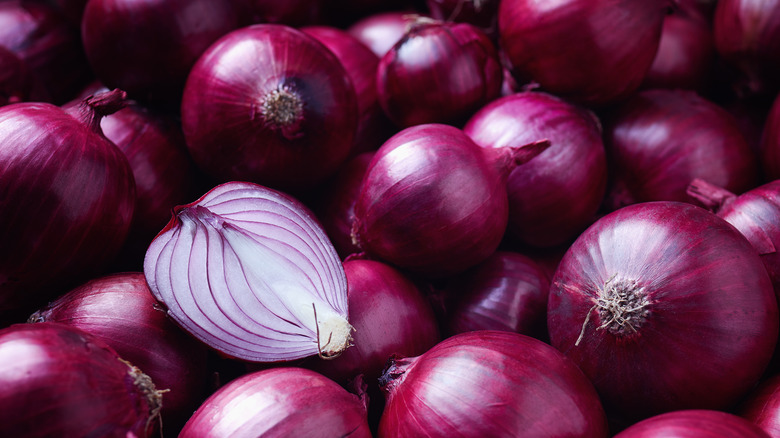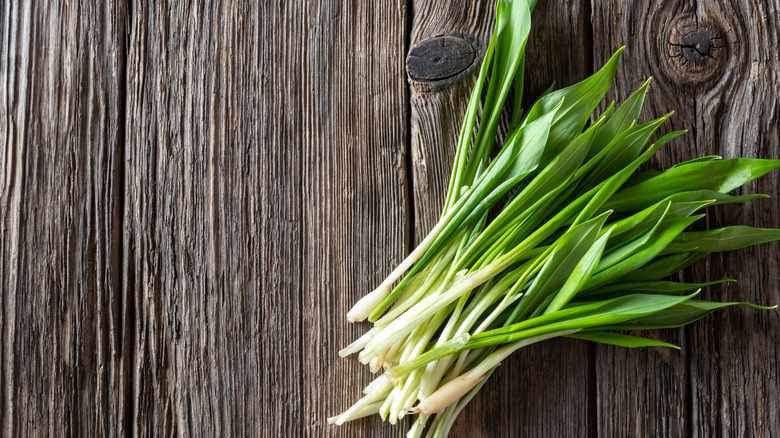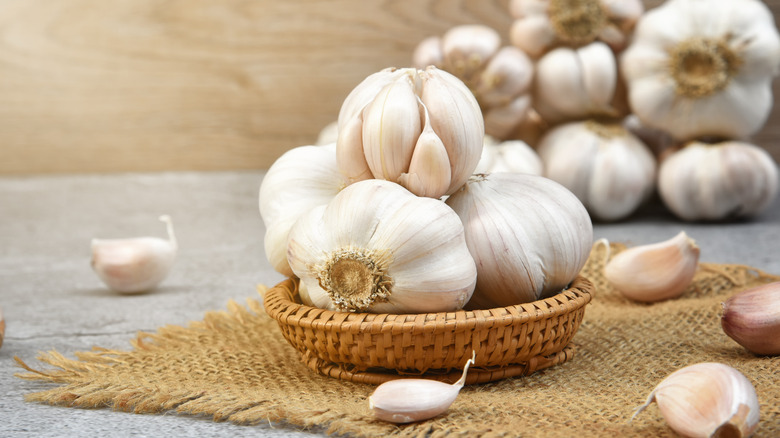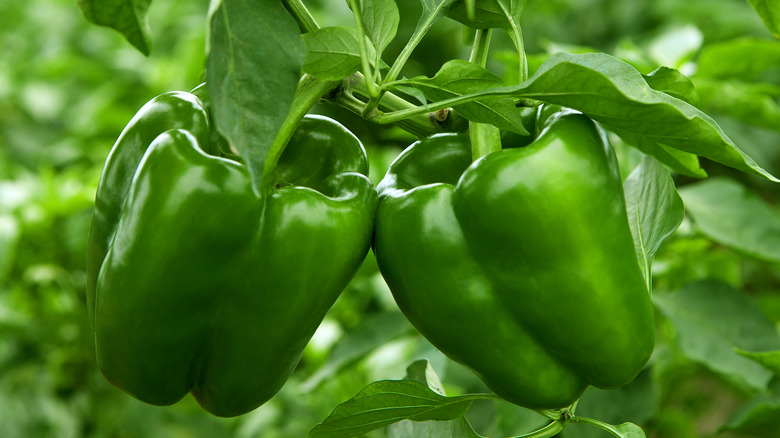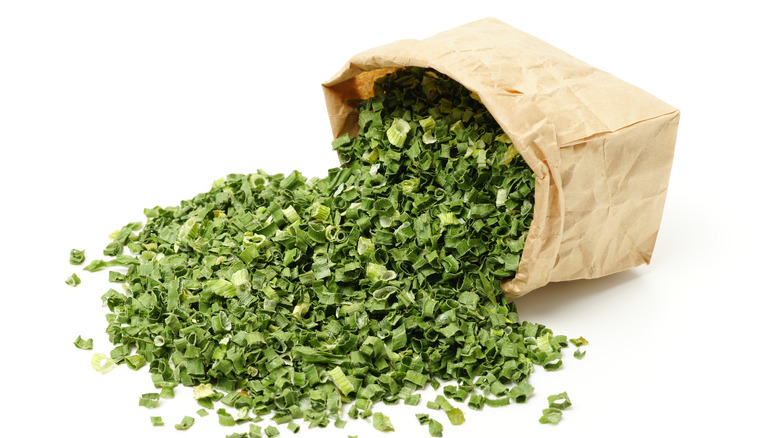10 Best Substitutes For Green Onions
Often confused with leeks, chives, and shallots, green onions are a tasty, versatile vegetable that can be enjoyed cooked or raw. They're great in everything from a classic street taco to a bowl of Vietnamese soup to an omelet or a potato. They're also technically the same thing as scallions, according to Escoffier Online. Green onions are hearty and easy to grow, able to be cultivated in soil or even grown hydroponically. They can even regenerate and grow back anew when the bulb and roots are preserved after the crunchy green stalk has been removed (via The Kitchen Whisperer).
And in case you ever wondered, word has it that the name of the 1962 instrumental hit song "Green Onions" by Booker T and the MGs was inspired by a cat of that same name, according to Memphis Rock n Soul. Though, another story goes that band leader Booker T wasn't initially happy with the track and called it "Green Onions" because in his words: "It's something you throw away."
For many who aren't Booker T, green onions are a delicious ingredient. And a nutritious one, too. According to WebMD, a cup of green onions delivers 200% of your daily needed vitamin K, 25% of your vitamin C, and 16% of your daily needed folate. Milder than an onion, green onions lend a fresh, oniony, and grassy flavor to dishes.
If you find yourself without green onions available, never fear: Your soup or potato can still be a triumph thanks to these suitable stand-ins.
1. Chives
You can readily be excused for confusing chives with green onions. They look remarkably similar and, in most ways, they are pretty similar. Chives come from a related but different plant species than green onions but they grow in much the same style (via Foodsguy). On close inspection, you will see that chives are a bit smaller than scallions, they are a bit darker green (when mature and ready for use), and they are markedly more fragile and prone to damage and wilting.
Chives also have a much more mild and sweet flavor than most green onions. Technically classified as an herb, not a vegetable, chives are usually used to add a subtle flavor to a dish rather than being treated like a primary ingredient — something green onions often are. All things considered, though, chives are a great surrogate for green onions and can be used in lieu of their heartier counterparts as needed.
In almost all recipes, whether they will be served raw or cooked, you can use chives as a direct substitute for green onions. Just note that they will cook much faster than their heartier peer, so adjust the cook times down accordingly and keep a close eye on your dish as you work. Savory Spice notes that because chives have a more delicate flavor, you may want to add more to get the same pop as the green onions.
2. Shallots
Milder and sweeter than most "traditional" onions (such as red and white onions) shallots can be used as a great stand-in for green onions when needed. They handle much like a traditional onion in that they have much the same texture and feel and take about the same amount of time to soften, grow fragrant, and ultimately caramelize when cooked, but their flavor profile is gentler, as noted by A Couple Cooks.
If you are going to use shallots instead of green onions, it's a good idea to slice these diminutive onion cousins into small pieces and to use a bit less of the shallots than you would of green onions, as their flavor is stronger than that of the scallion. Also note that shallots are best used in place of green onions in cooked recipes, while they're not as well suited when used raw, as you may use green onions when topping a soup, salad, potato, or other dish.
Shallots, when sliced thin, will cook about as quickly as green onions and can be used as a direct replacement for scallions. If you are serving them raw, note that they will add extra bite, so it's a good idea to use a smaller quantity.
3. Leeks
Leeks are quite similar to green onions in many ways albeit much larger in size. Unlike green onions, of which you eat those deep green stalks, with leeks you actually need to discard the thick, dark green leaves of the plant and instead cook with and eat the pale green and white parts of the stalk. Leeks are not commonly eaten raw but are delicious when fried or roasted. They make a fine green onion stand-in for most recipes, though they are less bold and slightly sourer.
A word of caution about leeks, though, and if you've heard this already, then just take this as more confirmation: Leeks are notoriously dirty vegetables. As in literally filled with dirt. Take care to thoroughly rinse every part of a leek you will be cooking with, separating the layers of the cylindrical onion and washing between them (via Food Network).
As noted, leeks are not everyone's favorite when served raw, so it's a good idea to at least sauté them quickly, then use them to top a soup or in a taco, for example. When cooking the leeks in place of scallions, you can use them as a direct substitute.
4. Ramps
You might not have heard of ramps, which are also often called wood leeks or wild leeks, and frankly, you might be hard-pressed to find them in most grocery stores. If you can find ramps, you will have located a very good substitute for green onions for most purposes. They have more of a garlic aroma and flavor profile than they do of an onion profile (via Substitute Cooking), but they offer the same mild but savory contribution as green onions, and they are a perfect sub when a recipe calls for both green onions and garlic if you lack both.
Ramps live up to their wild and wood names in that they do grow best in nature rather than when cultivated, thus the challenge of finding them in stores. With care, however, you might just grow adept at locating them in the wild and thus sourcing the freshest and most cost-effective green onion stand-in.
Ramps are a great substitute for green onions when they will be cooked, but as they do have that garlic profile, they are not a great stand-in for raw green onions, so it's best to reserve them for use in cooked dishes. One cup of chopped ramps can substitute ½ cup green onions, according to Substitute Cooking.
5. Yellow onions
Yellow onions are such a common foodstuff most people take them for granted, but try to imagine life if they were suddenly unavailable or even simply scarce and expensive. Countless recipes commence with the cooking of this vegetable and their flavor is an absolute necessity both as a base and, in many cases, as the main player, as in certain soups and roasted dishes.
While more potent than green onions and while they must be chopped and cooked differently than their milder counterpart, yellow onion, sliced thin and cooked properly, can be used as a substitute for green onions in many dishes, such as in omelets or soups. They also have the added benefit of excellent shelf stability and can be chopped then frozen.
As with leeks, yellow onions should be at least lightly cooked if you want to add them to a dish in lieu of raw chopped green onions. When used in a cooked state, The Pioneer Woman blog says you can swap in an equal volume of yellow onion for green onion. If you'd prefer your dish to be less pungent, just adjust the quantity down some, as yellow onions have a lot more potency than green onions.
6. Red onions
Red onions, like their yellow and white cousins, are much stronger in flavor than green onions, but their potent bite is greatly mellowed by cooking, so they are a suitable standby for scallions when needed for many recipes. However, unlike with yellow and white onions, which most people find unpalatable when not cooked, red onions can be enjoyed raw. For this reason, they are a good substitute for green onions in dishes where the scallions are not cooked, such as when sliced and added to tacos or potatoes or used to top soups.
To take a bit of the bite out of a red onion without cooking it, which greatly changes its flavor and also takes away the pleasant crunch, you can slice and submerge them in cool water for about 10 minutes (via Kitchn). Then rinse the sliced onions again once removing them from the cold water bath, dry the onion pieces, and use them as you would use green onions.
According to Substitute Cooking, with red onions you can go for a one-for-one replacement and enjoy them raw or cooked. Just make sure to increase the cooking time as they will take longer to soften and grow fragrant.
7. Green garlic
According to Kitchn: "Green garlic is really just a young garlic plant." Green garlic is sourced from the leafy stalks of the plant that grow above ground, whereas standard garlic is sourced from the bulbs that grow below ground. Green garlic is harvested before those bulbs have matured and it has a much more mild taste than the garlic cloves used in so many dishes. As such, it is much less overpowering and is a good substitute for green onions.
Also, unlike a regular clove of garlic which cannot well be eaten raw (you can safely eat raw garlic, for the record, but you will very likely regret your decision), green garlic can be sliced and added to many dishes raw, thus matching green onions in handling as well as being a decent (albeit decidedly more "garlicy") alternative in terms of taste.
Green garlic is a fine direct substitute for green onions in terms of texture and the way you will cook it, just know that it will impart more of a garlic flavor and aroma than an onion profile, which may not work with all dishes.
8. Garlic
Granted, garlic has a different flavor than green onions. No one is ever going to mistake one for the other and, in many cases, they cannot be substituted. However the flavor garlic imparts, both savory and with a bit of bite, is complementary to the flavor of scallions and can be used in place of its green compatriot. Garlic will help balance and support other flavors, such as those of kale or spinach or another bitter vegetable, in much the same way as a bunch of sliced green onions.
In short, you don't use garlic in place of green onions, exactly, but rather you use it instead of green onions. Or better yet, you can use both, as garlic and green onions work wonderfully together, especially in meat-centric dishes like with a sweet and savory chicken or in a beef roast (via Low Carbing Asian).
To be clear, don't serve raw garlic in place of raw green onion. And do adjust down the quantity if you're using it in a cooked step of a recipe.
9. Green bell peppers
If you are primarily concerned with adding some pleasing crunch and a bit of lovely color to a recipe, like for topping an omelet, soup, or piece of meat with a bit of green, then finely chopped green bell peppers are a decent stand-in for green onions. They will add just a bit of bite such as you would expect from the scallions, and they have a great crunch and look. Granted, the flavor added is different than you get with scallions, but it will usually work fine, just differently.
Lightly cooking the sliced green onions, either in a pan or better yet with steam, will reduce their bite and add some sweetness, and that's a good choice for their use in some recipes that call for green onion. You can also use a combination of green pepper and yellow onion to add the color and to get some legitimate onion taste in your dish.
Green bell peppers will add the color and crunch of a green onion and work well in many recipes when lightly cooked. For recipes where the green onion cooks fully along with other ingredients, you can match the called-for quantities. And of course, it goes the other way, too, according to My Conscious Eating: "Onions are a good replacement for bell peppers, especially if you need to fry the peppers."
10. Dried green onions
Just because you can't find any fresh green onions handy does not mean that you can't still easily add green onions into your cooking. Dried green onions have a long, stable shelf life and can be found on the shelves of any decent grocery store or can be ordered online. They work quite well when incorporated into soups or stews, used in roasts or slow cooker recipes, or when sprinkled into egg dishes, potato dishes, and more.
And if you are interested, it's actually quite easy to create dried green onions yourself (via The Purposeful Pantry). If you have a dedicated dehydrator, you can make a batch with just a few minutes of prep and then with a dehydrating session lasting between three to five hours depending on the unit you are using as well as the freshness of the vegetables in question. Just make sure to seal them properly in a completely airtight container once you are done with the process.
Dried green onions, being, of course, green onions, can be used as a direct substitute for their fresh state. You can even soak the dried green onions for a few minutes to partially rehydrate them and then use them as a near match for raw scallions. However, as the Pioneer Woman blog notes, this dried version does not work as well as a garnish.
